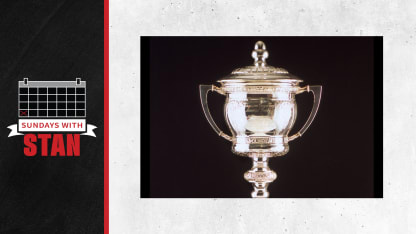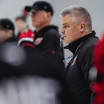At the end of every National Hockey League season, a vote is taken by distinguished media members and a recipient is picked for the Lady Byng Memorial Trophy.
The prize honors a player who exhibits blend of good sportsmanship and high-class performance over a season. It has been in play since 1925.
Calgary Flames sharpshooter Johnny Gaudreau, the most recent Byng Trophy winner, epitomized what The Great Lady had in mind when she commissioned the original trophy from her home in Ottawa.
But the chances are that New Jersey[-born Johnny Hockey would be hard-pressed to tell you very much about the handsome woman who conceived the prized silverware; nor that she was a heroine in her own right.
And I'll bet that there are few and far between who know that if it wasn't for World War I the NHL wouldn't have a Lady Byng Trophy to begin with; and I kid you not. So, let's get to the facts folks, only the facts.
Start with events that preceded what has been known as The Great War and that Marie Evelyn Moreton married Colonel Julian Byng in April 1902. Later to be known as Lady Byng, she toured the world with her husband from his one army posting to the next.
By 1917 the now General Byng was leading British and Canadian forces to a series of major triumphs over German forces. One was a decisive Battle of Vimy Ridge and second the Battle of Cambrai where Byng deployed the new weapon, tanks, so decisively that historians regard it as a pivotal triumph leading Germany to surrender.
"Baron Byng was rewarded by Canadians like me as a major war hero," said Frank Boucher, an eventual winner of the trophy. "And this even though he was a Brit, not a Canadian."
In only a matter or years, Canadians were able to embrace General Byng and his distinguished wife -- now Lady Byng of Vimy -- first-hand.
SUNDAYS WITH STAN: The Truly Amazing, Yet Unsung Lady Byng

Posted to Ottawa in 1921 as Canada's new Governor-General, Byng and his Lady became enamored of the Dominion and especially its citizens and their assortment of sports.
For five years Lady and Baron Byng of Vimy traveled Canada coast-to-coast and adopted the Canadians as their very own. They went to football games, enjoyed lacrosse and other sports.
"I got to like hockey most of all," she allowed during an interview. "My husband and I would go to the games whenever we had a chance."
It was only natural for the Governor General and his sporty wife to favor the hometown Ottawa Senators as their team. In no time at all Lady Byng had picked out a favorite player, Frank Nighbor.
"What I liked most about him," she explained, "is that he played the game so well but always within the rules. Watching Frank gave me the idea to donate a sportsmanship prize for the 1924-25 season."
She had a trophy struck and then invited Nighbor to the Governor General's residence, Rideau Hall, for a viewing. She then explained that it would be for a combination of fair play and sporting excellence and that he would be the first recipient.
"I appreciate gentlemanly play," she explained, "and good sportsmanship. I want this trophy to encourage and reward it."
Nighbor won it for the first two years (1924-25 and 1925-26) followed by Billy Burch of the New York Americans.
When the Governor General's posting ended in 1926. the Byng Family returned to their native England while maintaining their interest in NHL hockey.
Then, a strange series of events would unfold. New York Rangers Center Frank Boucher who patterned his game after the original Lady Byng Trophy-winner, Frank Nighbor, captured the award for the 1927-28 season.
But, guess what? The Rangers ace won it again, and again and again. Finally, at the end of the 1930-31 season after which Boucher won his fifth consecutive trophy, Lady Byng was impressed beyond all reason.
"It was then," she admitted, "that I felt I should give Frank the original trophy and have a new one presented to other players who would deserve it in future seasons."
As it happened, Boucher had another run of three straight Cups from 1932-33 through 1934-35, annexing Lady Byng Trophy, Jr.
That same year now Viscount Byng died at the family's estate, Thore Hall in Essex, England. Lady Byng -- now Viscountess Byng -- remained at the estate well after the start of World War II and the Nazi blitz from the air.
Defying the German bombers, she remained home until the British government persuaded her -- for safety's sake -- to move back to Canada for the duration; which she did, setting up residence in her beloved Ottawa.
Once again, now the second time around, she won the affection of Canadians by traversing the country from the Maritimes to British Columbia while volunteering with such activities as raising funds for the Red Cross.
At war's end, she bade good-bye to her Canadian friends as well as the NHL which continued to present the trophy in her honor.
So revered was she that Canadians honored her in absentia. A 2/4 march for bagpipes was composed in her memory. In addition Lady Evelyn River and Lady Evelyn Lake in Ontario's Timiskaming District were additonal memorials to the distinguished woman.
Lady Byng lived out her event-filled life for four more years until her passing at the family estate on June 20, 1949.
Perhaps it was appropriate that a year after her death the Lady Byng Memorial Trophy-winner was Rangers center Edgar Laprade.
The crafty center was a disciple of Frank Boucher -- now Laprade's general manager -- who played the game in the manner that Lady Evelyn wanted it played.


















